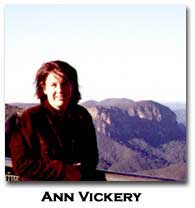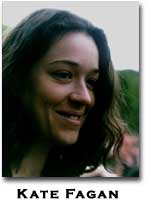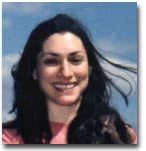
editors notes &, How2/5
by Ann Vickery
Reading back through Kathleen Fraser and Jo Ann Wassermans inspiring, provocative, and expansive first four issues of HOW2, I approached its editorship with some trepidation. Sharing their passion for innovative womens writing and scholarship, I hope to continue Kathleen and Jo Anns encouragement of work that challenges boundaries of text, genre, and discipline; that brings together critical and creative strands; and that explores in challenging new ways the relationship between writing and gender. While still following such a path, Id also like to open HOW2 up to other directions as well.
In this, I have the help of a new managing editor, Kate Fagan, and a revitalized editorial advisory board. Kate is currently completing a PhD thesis at the University of Sydney on ethics, seriality and collaboration in the writing of Lyn Hejinian. Her chapbook, return to a new physics, was published by Vagabond Press in 2000, and her first full-length book is due to be published early next year. While many familiar figures remain on HOW2s editorial board, there are a number of new faces that Id like to officially welcome too. Hilda Bronstein, Deb Comerford, Renee Gladman, Nada Gordon, Arielle Greenberg, Jeanne Heuving, Mytili Jagganathan, Anya Lewin, Kathy Lou Schultz, and Susan M. Schultz have been invited to join either because of their involvement with the journal or for their capacity to draw attention to writing from regions so far under-represented in HOW2. Kathleen and Jo Ann are also an integral part of the editorial advisory board and in overseeing the postcards and workbook sections of HOW2, remain active contributing editors.
Several changes may be noted in issue 5. Instead of a translation section, there is a special feature on emergent Australian poetry. While the translation section returns in issue 6, this feature section will continue to showcase the new writing of a different country for each issue. The Update section has been combined with Postcards, as the two sections were overlapping in their informal commentary of books and projects that might be of particular interest to HOW2 readers. The In Print section has also been substantially expanded in order that it become a useful database that is more international in scope.
Issue 5 considers textual experimentation through a diverse range of issues that could roughly be collected under the headings of embodiment, community, and the cultural politics of writing. The Writing Erotics section exemplifies poetics as a hybrid genre, performatively announcing their own agency. Critiquing cultural and philosophical conventions of the erotic, some contributors focus on the dialectic between pleasure and necessity in writing, while others extend this to the relationship between motherhood and authorship. The section sits well against not only the Australian featurewhich is drawn together around the theme of passionbut also a number of pieces in the New Writing section, including Caroline Bergvalls Fl鋊h, Dodie Bellamys Cunt-Ups, and Juliana Spahrs Unevenness. While the pleasurable may figure at one end of the spectrum, at the other is the body in pain, which Cynthia Hogue brilliantly expounds upon in her long poem The Incognito Body.
The concept of community is a relationship between self and other that is both imagined and acted upon. It begins with two figures, whether these are writer and writer, writer and reader, writer and publisher, or writer and critic. Yet it extends to the group, to local and global formations, to multiple affinities. In the mixed media section, the collaboration between Anna Reckin and Paulette Myers-Rich is a careful cross-stitching of word and image. Lara Odell and Anya Lewin both create, in quite different ways, a rich intertextual framework for their own poetics. Again, the flip side to influence is anxiety and contestation, which is explored at some length through the enigmatic Mina Loy in the in-conference section. Lastly, the retrospective On HOW(ever) considers the history of HOW(ever), the community of writers and readers that formed around it, and its shifting relationship to the academy.
The retrospective on HOW(ever) is a timely one as it is easy to take for granted the existence of HOW2 today. Due to the efforts of Cynthia Hogue, HOW2 found a home at Bucknell University in 1999. This relationship between journal and institution should not be overlooked: it is a relationship that is continually finetuned and that raises issues both of access and independence. We are particularly fortunate in having Roberta Sims as HOW2s web designer. Not only has Roberta been incredibly patient and helpful in this transition of editorship but I can begin to appreciate how much HOW2s high level of professionalism is due to her input. It is Roberta who ensures that each piece eventually works in an online environment (a particularly difficult task for a journal of innovative writing). She not only solves technical problems but helps create the look of HOW2. She also advises on any potential conflict between editorial opinion and university policy, helping out in issue 5 on just such a point. While Roberta is representative of HOW2s institutional support, she goes well beyond that role in her commitment to the journal.
Caroline Bergvall suggests that the lack of critical forums such as HOW2 has helped generate a kind of internalized silence among experimental British writers (see her introduction to Postings from Britain). While some might trace class-based histories or take up a dialectical language, there is a general reluctance to engage any further with issues of socio-cultural belonging. This contrasts with the overwhelming wave of identity politics in more recognizably mainstream poetry. Bergvall argues that to distinguish between the experimental and the mainstream in this manner can only be disabling. New ways of thinking about the genealogies of innovative poetry are required. Such undertakings are already occurring in the American context, as demonstrated in this issues in-conference section on African-American poetries.
The institutionalization of HOW(ever) and Caroline Bergvalls discussion of poetic formations in Britain reveal how issues of community are invariably shaped by cultural presumptions towards writing. Indeed, the three realms of embodiment, community, and the cultural politics of writing are interrelated rather than discrete areas of investigation in HOW2. In issue 5, Redell Olsen examines the commodification of female sexuality in Book of the Fur and discusses her book with Lucy Sheerman in the workbook section. The forum also debates aspects of oppression in writing today.
In issue 6, there will be a continued focus on collaboration (a special collaborative mixed media section). The forum will also discuss whether a transnational community is emerging in womens experimental verse, and the dangers or advantages attending such a shift. In particular, HOW2s own positioning as an international journal will be debated. The deadline for issue 6 is 15 July 2001. Section co-ordinators and their contact addresses will soon be posted on HOW2s website.
In addition : It is with sadness that I announce the sudden death of one of our most valued and proactive contributors, Ramez Qureshi. Ramezs review of Lyn Hejinians Happily appeared in issue 4. His review of Fanny Howes Selected Poems features in this issue. Both pieces reflect Ramezs great enthusiasm and sensitivity towards innovative poetry. The editors of HOW2 would like to extend our sympathies to Sofie and the rest of Ramez's family.
HOW2

|
Editor
/Publisher:
Ann Vickery |

|
Managing Editor:
Kate Fagan |

|
Web Designer:
Roberta L. Sims |
EDITORIAL
ADVISORY BOARD:
Hilda
Bronstein (UK): hildabronstein@comsave.co.uk
Eileen O'Malley Callahan (USA):
callahan@uclink4.berkeley.edu
Marina Camboni (Italy): mcamboni@diginet.it
Deb Comerford (Australia): debcomerford@usq.edu.au
Lisa
Docherty (New Zealand):
l.docherty@xtra.co.nz
Kathleen Fraser
(USA): kfraser@sfsu.edu
Kornelia Freitag (Germany): kfreitag.rz.uni-potsdam.de
Elisabeth Frost (USA) efrost@fordham.edu
Renee Gladman (USA): rgladman@php.ucsf.edu
Nada Gordon (USA): nada@jps.net
Arielle Greenberg
(USA): acgreenb@mailbox.syr.edu
Jeanne Heuving (USA): jheuving@u.washington.edu
Cynthia Hogue:(USA): hogue@bucknell.edu
Mytili Jagganathan (USA): mytilij@yahoo.com
Linda
Kinnahan (USA): kinnahan@duq3.cc.duq.edu
Anya Lewin (UK): a.lewin@dartington.ac.uk
Nicole Markotic (Canada): markotic@ucalgary.ca
Marina Morbiducci (Italy): marmob@libero.it
Frances Presley (UK): fpresley@compuserve.com
Linda Russo (USA): lvrusso@acsu.buffalo.edu
Kathy Lou Schultz (USA): klou@dept.english.upenn.edu
Susan Schultz (USA): schultz@hawaii.rr.com
Jo Ann Wasserman (USA): twoswirl@aol.com
HOW2 Internet Address (Bookmark it!):
http://www.departments.bucknell.edu/stadler_center/how2
Editorial correspondence may be e-mailed to:
avickery@astro.temple.edu
or kfag6311@mail.usyd.edu.au
Review copies of recent books may be
sent to:
Kate Fagan
26 Iredale street
Newtown, NSW 2042
Australia
The
HOW(ever) Archive, at Rutgers
Rutgers' Scholarly Communication Center hosts the HOW(ever) archive on
its web server at the address: http://www.scc.rutgers.edu/however.
The HTML editions of the original print version, volumes I-VI, [May 1983-January
1992] are available. As issues of HOW2 are completed, they will be added
to the archive.
Web Development, the HOW(ever) Archive at Rutgers:
Kathleen Crown, Miriam Bartha
Production Coordinators, Poetry in the Public Sphere
Delphine Khanna,Technical Consultant--SCC/CETH
Erin Griffith, Archive Production/Editing--SCC/CETH
Theresa Duhon, Proofreader, html translations
Gregory Murphy, Technical Consultant--SCC/CETH
Design, Stan Friedman
go to this issue's table of contents